 Multiple Choice Questions
Multiple Choice QuestionsWhich of the following statements about the birth rates (b1, b2) and death rates (d1, d2) of species 1 and 2 indicated in the figure is NOT true?
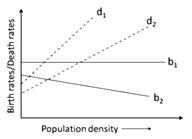
Birth rates of species 1 are density-independent.
Death rates of both species are density-dependent.
Birth rates of species 2 are density-dependent.
Density-dependent effects on death rates are similar for both the species.
D.
Density-dependent effects on death rates are similar for both the species.
Among the given set of statements, density-dependent effects on death rates are similar for both the species is an incorrect statement.
The following are matches made between adult animals and their larval forms:
A. Copepods - Nauplius
B. Sea cucumber - Zoes
C. Sea urchin - Echinopleuteus
D. Crabs - Auricularia
E. Star fish - Bipinnaria
F. Brittle star - Ophipleuteus
Which one of the combinations below reflects INCORRECT matches?
A, C, E
B and D
B only
F only
The phylogenetic tree of amniote vertebrates is given in the following diagram
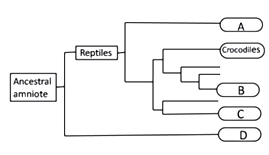
The groups labelled A, B, C, and D are
A - Snakes; B - Turtles; C - Birds; D - Mammals
A - Snakes; B - Turtles; C - Mammals; D - Birds
A- Turtles; B - Birds; C - Snakes; D - Mammals
A - Birds; B - Turtles; C - Snakes; D - Mammals
The following are some important features which are commonly associated with animals development:
A. Position of anus development with respect to blastopore.
B. Method of cell division.
C. Mechanism of coelom formation
D. Cleavage pattern during egg development.
Based on the above, which one of the following combinations differentiate the development of deuterstomes from that of protostomes?
A, B, and C
B, C, and D
A, C, and D
A and B
Following is a cladogram of the major taxonomic groups of the angiosperms:
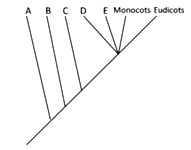
Group A-E represent respectively:
Astrobaileyales, Nymphaedales, Amborellales, Chloranthaceae, Magnoliids.
Amborellales, Astrobaileyales, Nymphaedales, Magnoliids, Chloranthaceae
Amborellales, Nymphaedales, Astrobaileyales, Chloranthaceae, Magnoliids
Amborellales, Nymphaedales, Chloranthaceae, Magnoliids, Astrobaileyales
A researcher conducts a standard test to identify enteric bacteria (A, B, C) on the basis of their biochemical properties. The result is given in the following table
| Test | Bacteria A | Bacteria B | Bacteria C |
| Indole | + | - | - |
| Methyl Red | + | + | +/ - |
| Voges-Proskauer | - | - | + |
Based on the above, the identified bacteria A, B, and C are most probably
Enterobacter, Salmonella, Escherichia
Escherichia, Salmonella, Enterobacter
Salmonella, Enterobacter, Escherichia
Escherichia, Enterobacter, Salmonella
Which of the following is the correct match of the algal group with its food reserve?
| Algal group | Carbohydrate Reserve |
| A. Bacillariophyceae | i. Oil |
| B. Xanthphyceae | ii. Floridean starch |
| C. Phaephyceae | iii. Laminarin |
| D. Rhodophyceae | iv. Chrysolaminarin |
| v. Starch |
A - (iv); B - (i); C - (iii); D - (ii)
A - (ii); B - (i); C -(iii); D - (iv)
A -(iv); B - (i); C - (ii); D - (v)
A - (i); B - (v); C - (iii); D - (ii)
Of the following, which one of the individuals will NOT necessarily carry the allele responsible for the mentioned trait?
A woman in a family where an autosomal dominant trait is segregating and her mother and son are affected.
A daughter of a man who is affected by an X-linked dominant trait.
A father of a child who is affected with an autosomal recessive trait.
A father of a boy affected with X-linked recessive trait.
The following diagram shows meiotic pairing in an inversion heterozygote and a point where single crossing over has occurred.
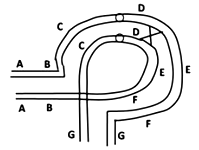
The resulting gametes produced may have
A. the chromosome having normal gene sequence.
B. the chromosome having inverted gene sequence.
C. a dicentric chromosome with duplication and deletion.
D. an acentric chromosome having duplication and deletion.
E. the chromosome having duplication and deletion.
Which of the following combination will be most appropriate for the diagram shown:
A, B, C, and D
A, B, and E
B, C, D, and E
A, C, D, and E
Three somatic hybrid cell lines, designated as X, Y and Z, have been scored for the presence or absence of chromosomes 1 through 8, as well as for their ability to produce the hypothetical gene product A, B, C, and D as shown in the following table:
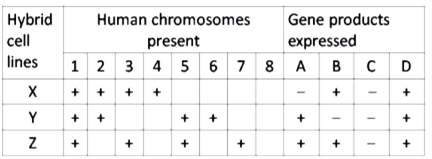
Which of the following option has most appropriately assigned chromosomes for each of the given genes?
Gene A on chromosome 5, Gene B on chromosome 3, Gene C on chromosome 8 and Gene D on chromosome 1.
Gene A on chromosome 5 and Gene B on chromosome 3 only.
Gene D on chromosome 8, Gene C on chromosome 1, Gene B on chromosome 5 and Gene A on chromosome 4.
Gene A on chromosome 5, gene B on chromosome 3, and Gene D on chromosome 1.
